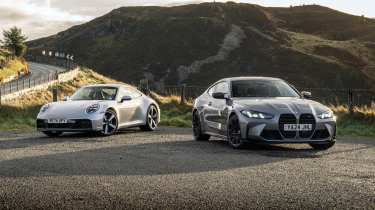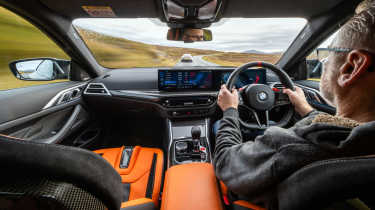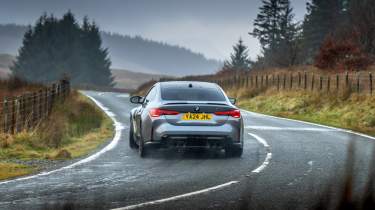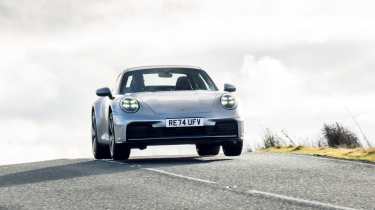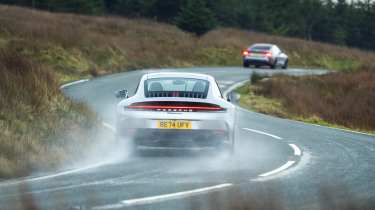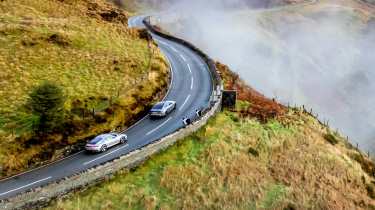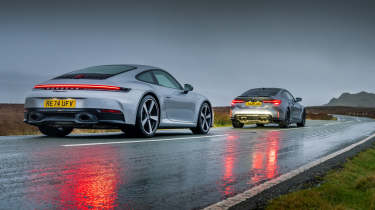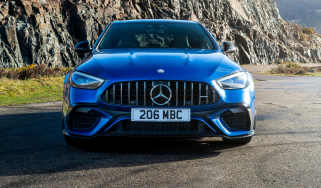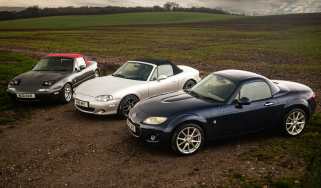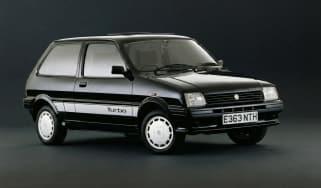BMW M4 v Porsche 911 – six-cylinder sports coupe titans do battle
Lighter and more focused, can the new Porsche 911 beat the more powerful, less expensive BMW M4?
The rain has petered out and suddenly the sun breaks through the clouds, painting the monochrome scenery with swathes of rich colour. Glassy patches of standing water still demand circumspection, but stroking the new BMW M4 Competition along these undulating roads, I can’t help thinking I’m in the right car. I might not be able to use all of the straight-six’s considerable power, but what I am confident enough to use should get to the road without much drama thanks to the xDrive four-wheel-drive system. It’s going to need to feel right at the top of its game today because waiting at the rendezvous point is an old enemy newly refreshed: the 992.2 Porsche 911 Carrera. As we’ve already reported, despite having none of the hybrid kit of the GTS, the base 911 is a capable and compelling coupe that feels good value, even though it’s got less than 400bhp and costs £100k before you even look at the options list.
The rear-drive M4 Competition that launched the G82 M4 range was discontinued just over a year ago when power was raised by another 20bhp to an even more substantial 523bhp and all models became four-wheel drive. The good news is that with xDrive the M4 is still rear-drive – and feels it – until the rear tyres can’t put any more torque down, when drive is then shared with the fronts. The bad news is that the system adds another 50kg to what was an already hefty 1725kg kerb weight. To BMW’s credit, the M4 doesn’t seem that heavy, feeling every bit as responsive as a car a couple of hundred kilos lighter.
The M4 starts with both a price and power advantage, costing £10k less while offering over 130bhp more, but there’s nothing new in that. BMW’s coupe has undercut and outgunned the corresponding 911 since the mid-’90s, when the E36 M3 had 282bhp to the 993 Carrera’s 268bhp. The power discrepancy has never been as big as it is today, though, and the surprising thing is that both the M4 and new Carrera are powered by 3-litre, twin-turbo sixes. They’re installed at different ends of course, but the BMW’s straight-six is so much more muscular than the Porsche’s flat-six, it’s almost as if they’re from different eras.
Climbing into the M4 on a chilly, wet morning, you find yourself longing for a little comfort, a bit of give, but you’ve got to wriggle between the steering wheel and over the unforgiving contours of the seat before you can get started. Visually, this M4 is a bit of a challenge too, its demure grey paintwork contrasted with McLaren-like papaya orange leather trim. Business on the outside, party on the inside. BMW calls it Kyalami Orange and it’s wrapped over optional, full carbon-shell bucket seats, complete with the familiar ‘carbon codpiece’.
Push the start button and the sound of the straight-six at a high idle is everything you’d hope for: rich, gravelly, resonant. Its character is closer to the croon of a classic BMW Motorsport six on individual throttle bodies rather than an emissions-compliant, 2025 production engine with intake-dampening turbos and a catalysed and GPF’d exhaust system. Good job.
> Porsche 911 GT3 (992.2) 2025 review – the best GT3 yet?
Get rolling and there’s a robustness to the M4’s ride that I don’t recall from earlier drives, with every lump and bump reported, though a subsequent call to BMW reveals no changes to springs or dampers since the power uplift. Bright steering adds to the sense of tension and so it takes a little while for you to settle into the car, soften your inputs to smooth your progress and get into the groove.
Of course, there are many tuning options. I’m not a fan of the facia layout with its extended single screen and jagged speedo and tacho graphics, which look to me like they’ve been lifted from an ’80s Atari game and simply aren’t easy to read, but a scroll of the centre screen shows that the M4 is currently set up for efficient performance, with dampers, steering and brakes set to Comfort (yep, you can tune the brake pedal response). You’d expect things to get even more urgent when you move away from Comfort, but for me the steering lacks heft in its initial setting and switching up to Sport brings more weight to lean into and helps calm things down.
Perhaps it’s because it’s cold and the wipers are busy that the 3-litre motor feels monstrously potent. Even on part throttle the mid-range lunge is epic. In a straight line, even on puddled roads, the M4 is mighty, all power in harness, straight-six yowling enthusiastically. It’s a bit different in the corners.
There’s no shortage of rubber, the Michelin Pilot Sport 4 Ss measuring 275/35 R19 front and 285/30 R20 rear, and it’s a long-wheelbase car too, but even in regular 4WD mode you can sense the rear edging wide, triggering the traction control, sometimes as you turn sharply into a corner, sometimes as you’re getting on the gas on the exit. It’s all very measured though, all perfectly predictable – you know when it’s going to happen. So for the last few miles on some favourite roads I’m dialled in, carving through the turns confidently and nailing it on the straights, just respecting standing water.
The Porsche is already at the meeting point and it looks neat, polished. Smaller than the BMW but chunky for a 911, filled out. This example is well north of £100k, helped over by the silver paint (£1068; only black and white are no-cost options) and larger diameter wheels, which look in scale with the body. Standard is 19/20 inches front and rear; these 20/21-inch ‘Carrera Classic’ five-spokes are £1910 and there’s another £20k-worth of options, most of which have no direct impact on the driving experience.
It seems that in the same way you go into IKEA for tea lights and come out £300 lighter, so you browse a German options list for wheels and come out £20k lighter… and in both instances an hour later you can’t see what you’ve bought. The BMW in turn benefits from over £25k of options, though that does include carbon-ceramic brakes.
The 911’s seats are much less obviously sculpted, more comfortable and just as supportive, and set lower into a lower-built car too. Press the start button and you discover that BMW’s engineers don’t have the monopoly on making modern turbo motors sound naturally aspirated, though you will have to have splashed out £2249 on the optional sports exhaust. The Carrera’s flat-six has a lovely growl right from the off, and it can be enhanced, made deeper, by pressing the exhaust button. Better still, the engine feels responsive like it’s naturally aspirated, which is quite a trick.
That’s not the 911’s only trick, either. Initially, its steering feels heavy and a bit slow, especially after the M4’s, but pick up the speed a little, guide the 911 into a few proper corners, and suddenly it feels exactly right: well weighted, uncannily precise yet calm. Same goes for the chassis. The secondary ride is a bit busy but the primary movements are beautifully controlled so the car carries speed with a remarkable lack of fuss, even over some of the most challenging sections.
> BMW M4 CS 2025 review – the M4 sweet spot we’ve been waiting for?
There are modes, too, and while the 911’s à la carte menu isn’t quite as extensive as the M4’s, its damping offers greater bandwidth. Select Wet mode via the rotary switch that hangs off the Porsche’s steering wheel and you can feel the dampers relax and the ride become more loose-limbed, enhancing grip.
You might even find the car messaging you, encouraging you to select Wet mode because it can sense the level of grip, but while it’s pretty useful here in north Wales, after a few miles of gnarly twists and turns you will have discovered that it’s not necessary because the amount of grip the Carrera finds on these sodden roads is quite astonishing. Porsches always have impressive wet grip; we’ve driven Boxsters, Caymans and 911s on greasy tracks when they seem somehow to find another level of grip, an extra 20 per cent over everything else. But this 911 seems to have found another level again.
Front-end grip is ridiculous and the rear is just as well stuck down. Point it across the mountains here, drive as fast as you want or dare, and it doesn’t put a wheel wrong. There’s fair feedback through the steering and great precision, but you can’t really tell where the limit is, just when the front is going to run out of grip, though partly this is because you can’t believe how trenchant is the grip of the Pirelli P Zeros. Load the car into a turn and give the wheel an extra sharp input and you’ll feel the nose just slip and slur a little wide on the wet asphalt; gas it hard and the rear might give a little shimmy too.
I arrived here in the BMW feeling energised, a bit heroic even, working the grip and balance to get the four-wheel drive hooked up on corner exits to allow the phenomenally grunty engine to rocket us onto the next straight. Now, getting back behind its wheel after a revelatory blat in the Porsche, the M4 feels, well… mortal. Grip is decent, comprehensible, the BMW feels busy, tautly resisting the road, demanding your attention where the 911 was settled in, locked on line and relaxed.
Thing is, the chassis of the new base 911 is arguably not the best thing about it. That’s the drivetrain. It sounds like flat-sixes of old and feels like one too, with crisp throttle response and willing delivery. Looking at the figures, the Porsche should feel properly outgunned. It’s not only 134bhp down, it’s also well short of the BMW’s torque, delivering a peak of 332lb ft versus 479. Four-wheel drive helps the M4 get all that down and hit 62mph in an impressive 3.5sec, six tenths faster than the 911, yet on the road its advantage is not so clear cut.
The 911 has the snap-open throttle advantage, getting the drop on the M4 thanks, it seems, to a combination of its engine delivery, gearbox response and lesser mass, though if the straight is a decent length, the M4 quickly gets into its stride and is all over the back of the 911. Both engines are tuned to deliver peak torque early and then maintain it, but the Porsche peaks a little earlier, has 250kg less to get moving, and its eight-speed, dual-clutch PDK gearbox feels very direct. The BMW’s eight-speed ZF is a great ’box, really quick-shifting for a conventional auto, but the M4 can’t quite match the keen response of the 911.
As the day goes on, rising temperatures and drying roads are definitely more to the M4’s liking. Although the mercury has only risen to six or seven degrees, to the cusp of where summer tyres start to work, the M4 is becoming more approachable and exploitable. It still feels overly bright in steering response but better grip means it’s calmer in corners, and you can get your foot down earlier on the exit and keep it there.
If you’re up for exploring the limit of grip with the systems still in the background, the mode choice is still MDM (M Dynamic Mode), which gives a strong rear-drive bias but steps in with four-wheel drive so things never get too far out of shape. You have to be quick-witted – not to mention confident – to dial everything back and go pure two-wheel drive because the tail is still fairly snappy, though you can mitigate the risk by dialling the excellent, scalable traction control up or down to match your confidence and the conditions.
> BMW M5 (G90) review – more power, more weight, same old M5 desirability?
Of course, there are steering-wheel mode buttons to fast-track you to personalised settings. It’s pretty wild that you can adjust brake feel, though Sport just seems to firm up the pedal a bit, which is probably reassuring if you’re on track and jumping on the brakes, or maybe left-foot braking.
The Porsche can raise its game, too, but is altogether less expressive. Across all sorts of terrain you can feel like you’re a great driver because it feels so calmly composed, never putting a foot wrong. Generally, Normal mode does for every scenario, but when the road gets particularly challenging, a press of the damper button consolidates body control.
Cornering grip is extraordinary, traction phenomenal, so you can exploit so much of the performance so much of the time. The missing ingredient is perhaps the sense that you’re making a difference. Even when you’re pushing on in the wet there’s rarely any sense of slip, which is remarkable, but it means there’s less to do. And it seems that even when you turn everything off, there’s always a little bit of residual stability control lurking in the background.
Maybe the slightly smaller, standard wheels and tyres have a little more give in them, a bit more movement to manage. Maybe they improve the low-speed ride quality, too. There aren’t many things that rankle in the 911 but one is the knobbly low-speed ride, and that’s on P Zeros, often chosen for their slightly softer sidewall. The other gripe, which is more obvious on typical B-roads, is the scale of the 911. On the sweeping roads up here you can forget how wide it is and then suddenly be concerned for the door mirrors when you encounter traffic on narrower roads.
The M4 is a big car too, of course, but you’re more on top of it, literally. It’s such a bright, responsive car that being on top of it driving-wise takes more effort; the M4 with everything set to Comfort feels like the 911 dialled up to Sport or Sport Plus, it’s that alert, that responsive. You have to work at it a bit, figure it out, find out how to drive to its strengths.
You’ll find a chassis that allows you to explore the limits of grip, exploit its four-wheel-drive traction and feel rewarded, without leaving it all to you. And, of course, it’s got an epic engine with bags of character and a phenomenal mid-range. You just wish the car would relax sometimes.
The 911 can make the same sort of progress but with considerably less tension. It’s kind of counter-intuitive, the four-wheel-drive car demanding more from its driver, being more of a challenge to exploit than the rear-engined, rear-driver, but the 911 has such prodigious wet-weather composure it makes exceptional progress on streaming roads feel easy.
You don’t ever feel a need to rev it out, stroking it to 5000rpm is enough, though with the must-have sports exhaust, if you select gears manually you can tap into the rich soundtrack of the flat-six. Sometimes, though, you want to feel more involved, to feel you’re really making a difference.
> Used Porsche 718 Boxster Spyder (2019 - 2025) review – the drop-top Cayman GT4
Of course, Porsche 911s have been heading in this direction for many years now, each new generation becoming dynamically more balanced, less obviously rear-engined, demanding less from the driver to exploit the traction and grip afforded by its layout. In that sense, the new base Carrera is the natural conclusion. It’s such a polished product, not just dynamically but in most other functions; there’s even an impressive slickness to its stop-start function, the way it cuts the engine before you come to a halt and then restarts almost seamlessly.
And, of course, since time began, journalists have bemoaned the fact that each new generation has less character and is less involving than the last. The exception was the 991; it took time for Porsche to exploit all its potential, and the true measure of that is whether the base model hits the spot. Well, despite a massive shortfall in power, the 992.2 Carrera is more than a match for its closest rival, the BMW M4 Competition. It’s not perfect but it’s close enough: the base Carrera delivers.
Porsche 911 Carrera v BMW M4 Competition specs
| Porsche 911 Carrera (992.2) | BMW M4 Competition | |
|---|---|---|
| Engine | Flat-six, 2981cc, twin-turbo | In-line 6-cyl, 2993cc, twin-turbo |
| Power | 389bhp @ 6500rpm | 523bhp @ 6250rpm |
| Torque | 332lb ft @ 2000-5000rpm | 479lb ft @ 2750-5730rpm |
| Weight | 1520kg | 1775kg |
| Power-to-weight | 260bhp/ton | 299bhp/ton |
| Tyres as tested | Pirelli P Zero | Michelin Pilot Sport 4 S |
| 0-62mph | 4.1sec | 3.5sec |
| Top Speed | 183mph | 155mph |
| Basic price | £99,800 | £88,985 |

